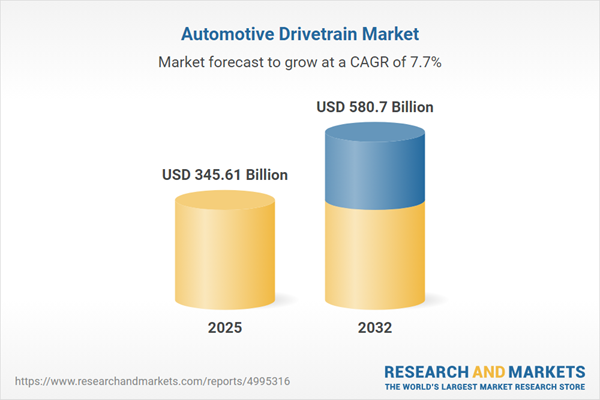Speak directly to the analyst to clarify any post sales queries you may have.
The automotive drivetrain market is experiencing rapid transformation, driven by innovations in electrification, advanced materials, and digital integration. This research provides a comprehensive, data-driven overview tailored for senior decision-makers navigating evolving technology landscapes and regulatory complexity.
Market Snapshot: Automotive Drivetrain Market Growth and Dynamics
The automotive drivetrain market grew from USD 320.34 billion in 2024 to USD 345.61 billion in 2025, with a projected CAGR of 7.71%. By 2032, the market is forecasted to reach USD 580.70 billion. This robust expansion is fueled by a combination of stringent emissions regulations, active development in electrified powertrains, and increased adoption of digital control solutions across vehicles worldwide.
Scope & Segmentation: Understanding Market Opportunities
- Component Segments: Axle (front and rear), Differential (limited slip, open, torque vectoring), Transfer Case (chain drive, gear drive), and Transmission.
- Transmission Types: Automatic, Manual.
- Drivetrain Types: All Wheel Drive, Rear Wheel Drive.
- Powertrain Types: Electric Vehicle, Fuel Cell Vehicle, Hybrid.
- Vehicle Categories: Heavy Commercial Vehicles (bus, truck), Light Commercial Vehicles (pickup, van), Passenger Cars (hatchback, sedan, SUV).
- Regional Coverage: Americas (United States, Canada, Mexico, Brazil, Argentina, Chile, Colombia, Peru), Europe, Middle East & Africa (United Kingdom, Germany, France, Russia, Italy, Spain, Netherlands, Sweden, Poland, Switzerland, United Arab Emirates, Saudi Arabia, Qatar, Turkey, Israel, South Africa, Nigeria, Egypt, Kenya), and Asia-Pacific (China, India, Japan, Australia, South Korea, Indonesia, Thailand, Malaysia, Singapore, Taiwan).
- Leading Companies Profiled: Aisin Corporation, American Axle & Manufacturing, Inc., BorgWarner Inc., First Brands Group, LLC, Dana Incorporated, Eaton Corporation PLC, Exedy Corporation, Valeo, HYUNDAI TRANSYS Co., Ltd., JATCO Ltd, Robert Bosch GmbH.
Key Takeaways for Senior Decision-Makers
- Technological advancements in electrification and digital integration are redefining drivetrain system architectures and vehicle performance.
- Strategic investments in lightweight materials and modular designs enable enhanced efficiency and adaptability across both traditional and electrified vehicles.
- Collaborative partnerships between OEMs and suppliers expedite the deployment of integrated electric e-axle solutions and software-based driveline controls.
- Shifting regional dynamics demand agile supply chain strategies, with increasing emphasis on near-shoring and vertical integration to reduce lead times and capitalize on local market incentives.
- Continuous innovation, such as predictive maintenance platforms and over-the-air software updates, is creating new business models and aftersales service opportunities.
Tariff Impact: Navigating Cost Pressures and Supply Chain Shifts
US tariffs enacted in 2025 have significantly influenced supply chains and production economics within the automotive drivetrain sector. OEMs and suppliers have adjusted sourcing models, prioritized North American manufacturing, and accelerated near-shoring to Mexico and Canada. This has required increased capital investments in tooling and workforce upskilling, while also driving exploration of new joint ventures and digital tools for cost management.
Methodology & Data Sources
This report leverages primary research, including expert interviews with OEMs, tier-one suppliers, and drivetrain engineers. Secondary sources such as technical whitepapers, patent databases, and regulatory filings support robust cross-validation. Data accuracy is ensured through systematic triangulation and best-practice benchmarking.
Why This Report Matters
- Empowers executives to prioritize investment in electrification and digital solutions relevant to evolving drivetrain market demands.
- Enables informed decision-making through granular segmentation and competitive landscape analysis across all major global regions.
- Supports resilience planning by detailing policy impacts, supply chain scenarios, and innovation trends shaping the future automotive drivetrain market.
Conclusion
The automotive drivetrain market is in a phase of rapid evolution, propelled by technology and regulatory shifts. Organizations adopting cross-disciplinary collaboration and agile supply strategies will be best positioned to define future industry leadership.
Additional Product Information:
- Purchase of this report includes 1 year online access with quarterly updates.
- This report can be updated on request. Please contact our Customer Experience team using the Ask a Question widget on our website.
Table of Contents
3. Executive Summary
4. Market Overview
7. Cumulative Impact of Artificial Intelligence 2025
Companies Mentioned
The companies profiled in this Automotive Drivetrain market report include:- Aisin Corporation
- American Axle & Manufacturing, Inc.
- BorgWarner Inc.
- First Brands Group, LLC
- Dana Incorporated
- Eaton Corporation PLC
- Exedy Corporation
- Valeo
- HYUNDAI TRANSYS Co., Ltd.
- JATCO Ltd
- Robert Bosch GmbH
Table Information
| Report Attribute | Details |
|---|---|
| No. of Pages | 184 |
| Published | November 2025 |
| Forecast Period | 2025 - 2032 |
| Estimated Market Value ( USD | $ 345.61 Billion |
| Forecasted Market Value ( USD | $ 580.7 Billion |
| Compound Annual Growth Rate | 7.7% |
| Regions Covered | Global |
| No. of Companies Mentioned | 12 |









